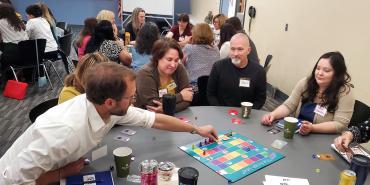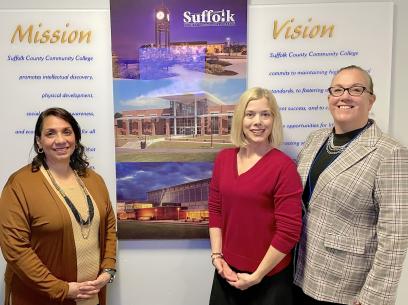At Suffolk County Community College in New York, faculty and staff gather each summer for real talk about diversity, equity and inclusion, and throughout the year they share strategies about how to be “more JEDI.” No, not Jedi knights in “Star Wars.” The JEDI acronym means “just, equitable, diverse and inclusive.”
Thanks to the union—the Faculty Association of Suffolk Community College—JEDI has become a staple professional development tool on the college’s three Long Island campuses. Funded in part by an AFT grant and run by FASCC in partnership with management, it uses workshop-style sessions supplemented with informal video clips and field reports to give faculty and staff the tools they had been asking for: among them, advice about how to be more inclusive of all their students, how to navigate differences in the classroom, and how to handle “hot moments” during class discussions.
These moments do come up, whether they center around politics, ethnicity, race or religion. JEDI sessions consider techniques to handle them so students feel supported, not threatened. Among other JEDI topics at the school, which is a Hispanic-serving institution with a high percentage of Latino students: assistance for first-generation students unfamiliar with college expectations, tips on engaging students who are lagging behind, and information about campus support services. Taken together, JEDI sessions have begun to make a real difference.
“I cannot say enough about the work that has been done over the past few years at our college and the JEDI program,” says mathematics professor Rachael Millings, who attended JEDI sessions last summer. “It may not be the perfect solution, but it will be part of the larger solution for our community.”
Structure
The JEDI Institute, now in its fourth year, begins with three five-hour sessions covering basic concepts of diversity, equity and inclusion. FASCC President Dante Morelli welcomes participants, and SCCC President Ed Bonahue is a featured speaker; deans, vice presidents and SCCC’s chief diversity officer, Christina Vargas, who is co-chair of the JEDI Institute, all participate.
“Part of our success is absolutely that it’s a union-administration collaboration,” says FASCC Secretary Cynthia Eaton, an English professor who helped initiate the institute with co-founders Vargas and SCCC Vice President for Student Affairs Patricia Munsch and is now its co-chair. Administrators bring “institutional solidity,” she says, while the union brings a wide range of faculty and staff participants. “There’s no hierarchy,” says Eaton. Academics share ideas with administrators, public safety officers, librarians and others who work on campus.
Throughout the workshops, participants consider how they might apply some of the concepts they are learning into their own work. Then they craft a project that would help them make change. In a session the following semester, participants report back and share how their projects are going.
This is how we do it
“I feel that community college in particular … is about equity,” says Millings, explaining why she attended JEDI sessions. She notes the open access that is a signature of SCCC and other institutions like it and says that “it is incumbent” upon instructors that the equity mission become part of the student experience.
That’s not always the case—and that’s where JEDI comes in. “We all have something we can do in our classes, no matter how small,” says Eaton. She has set up a platform for faculty and staff to share, through video and written accounts, exactly what they do to “be more JEDI.”
Biology professor Jean Anastasia starts class by inviting students to share any struggles they are having with content or “just in life,” allowing students to develop relationships with one another—especially important for under-represented groups in STEM fields, who may feel they don’t belong. Meteorology professor Scott Mandia takes students beyond the stereotypical image of scientists as old, white men and provides lists of racially diverse scientists for them to profile.
Another professor, Joseph Bernat, recognized math anxiety among some student demographics; he relieves that pressure by giving out the answers to algebraic problems up front, encouraging students to focus on understanding mathematical processes instead. Counseling professor Jared Dowd shares information about scholarship opportunities that could help students stay in school; his efforts may help raise retention numbers that are most challenging among Black and Latino students.
Many professors interrupt their lectures to poll students, who give a quick thumbs-up/thumbs-down/thumbs-in-the-middle to indicate how well they are following the material: That way, “every student can give me feedback without drawing too much attention to themselves,” explains Tom Flesher, who teaches economics.
Considering solutions like these takes time, which is why FASCC has set JEDI sessions outside the normal schedule of classes and meetings. “JEDI gave me some time in the summer to take a step back and ask myself, ‘is this experience that a student has in your classroom equitable?’” says Millings. With a heightened awareness of possible disparities in the classroom, she compared outcomes and class participation according to race and gender and was surprised to see that despite her efforts to treat every student fairly, white men were more actively engaged and academically successfully than women, Black students and Latino students. The information made Millings especially uncomfortable because, she says, “I am not male, and I am a person of color. You can imagine personally I’m looking at this and reliving some of my experiences in the classroom.”
“I had never taken the time to look at the racial or gender similarities or disparities in my final grade rosters,” says Millings. JEDI gave her the nudge she needed to consider what she calls a systemic issue playing out in her classes, and now she is exploring how she might better prepare her students for success.
Plans for improvement
English professor Naomi Edwards is also recalibrating her classes based on what she learned at JEDI: She was surprised to learn that many students come from essentially segregated high schools and are experiencing diverse classrooms for the first time. Edwards had assumed students would be more prepared to discuss race and class in her multiethnic literature class. Now she brainstorms ground rules with them, to ensure more supportive and inviting discussions.
At least one student has already benefited directly from Edwards’ exposure to JEDI: An undocumented student needed help understanding his options, and Edwards was able to connect him with the college’s undocumented students task force and related legal counsel. “That was something that I would not have known was available to students,” she says.
When accounting instructor John Capurso joined the JEDI session, he admits that while he already incorporated inclusive ideas in his classroom, the JEDI framework, lingo and even some concepts were unfamiliar, and he felt intimidated. “I’m a middle-aged white man,” he says. “I’m not exactly the mascot for the diversity movement.” The session’s welcoming setup and the idea that everyone is in a different place with “the work” put him at ease. “The best thing about the JEDI is that it’s based on action,” he adds. “You create your own marching orders.”
Capurso’s culminating project? He is establishing an SCCC student chapter of NABA, a prominent national organization of Black business leaders. “Crazier things have happened,” he says, admitting that he had some misgivings as a white man organizing a Black club chapter—but his department had no Black full-time faculty to do the work, and he is convinced students could benefit from an organization that would connect them to Black professionals and possible mentors. As faculty adviser, Capurso plans to stay in the background and hand over the reins when his department diversifies to better reflect the changing student body.
JEDI leaders hope that these sorts of projects inspire and support students, not just in accounting but across all departments. Even small changes are already changing lives. Eaton especially loves to share the story of Ana Fuentes, an adult student who didn’t speak English when she started classes; she felt as though she didn’t belong in college at all. But one faculty member recognized her capabilities and took the time to tell her she should enroll in the honors program. Fuentes wound up winning several scholarships, graduated from SCCC and is now thriving at Stony Brook University.
“It absolutely changed the trajectory of her life,” says Eaton of that brief faculty-student conversation. She hopes JEDI will continue to generate similar stories of success and connection.
[Virginia Myers]


